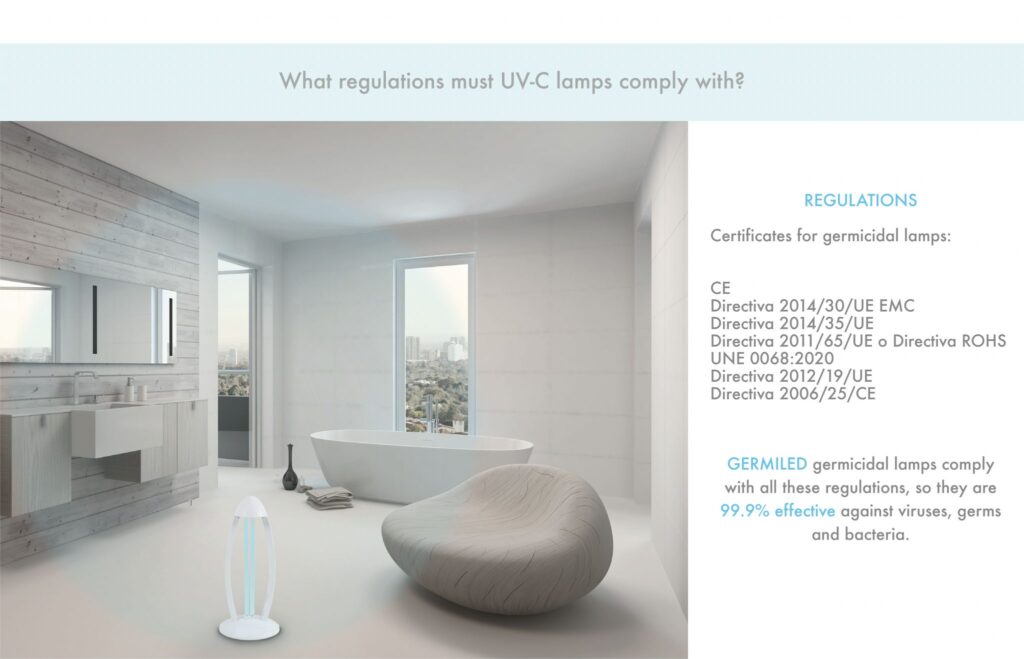Due to the increasing demand of germicidal lamps, we can find there is a large number of models in the market that vary not only in shape or size, but also in price.
The last one usually varies according to the tests that the product has passed. This kind of certifications are very important, because they not only guarantee us the quality of the product, but also make sure the germicidal lamps are safe.
Certificates for germicidal lamps:
CE: This certification is a necessary requirement to make products placed in European markets. It is an indicator demonstrating that the product has met the current legislations and has been evaluated before its commercialization.
Directive 2014/30/EU EMC: It has two main objectives: to respect the radio spectrum in order to facilitate communications networks, and to ensure that all electronic products can be electronically compatible with each other. In this way, they will be able to function properly.
The following list indicates the standards that are most frequently applied:
- EN 55015:2013
- EN 61547:2009
- EN 55014-2:2015
- EN 6100-3-2:2014
- EN 61000-3-3-2013
Directive 2014/35/EU: This is the Low Voltage Directive, also known as LVD. There are not many detailed requirements included but we can find some harmonized standards. All the requirements for “good electrical safety practice” are found in European standards (EN). By applying the harmonized standards, we are sure our products could comply with the LVD standard.
Below is a list of the harmonized standard that are most commonly used:
- EN 61347-1:2015
- EN 61347-2-13:2014
- EN 61347-2-13/A1:2017
- EN 62493:2015
Directive 2011/65/EU or ROHS Directive: This directive restricts the use of certain hazardous substances in the electrical or electronic field (EEE).
UNE 0068:2020: It is not a compulsory regulation, but it is advisable that germicidal UV-C lamps comply with it. It indicates a series of general requirements that germicidal apparatus or equipment with UV-C radiation should meet to prevent people and animals from certain damages. You can read more about this regulation in the previous article we published.
Directive 2012/19/EU: This directive about waste electrical and electronic equipment (WEEE) aims to establish measures to protect the environment and human health.
It requires the manufacturer or supplier to register in RII-AEE (Integrated Industrial Register) in order to ensure that they are prepared to make effects to punish the polluter.
Directive 2006/25/EC: This contains the basic rules on health and safety regarding the exposure of workers to risks arising from physical agents (artificial optical radiation).
It ensures the apply of the product will not do harm to those people who are working or those may be exposed to artificial optical radiation during their work.
For this reason, limit values for exposure to incoherent radiation emitted by the anticipated source are established, in the case in question UVC, Heff=30J/m², a value referring to 8 hours, the body part/risk being as follows:
- Eyes:
- Cornea – Photokeratitis.
- Conjunctiva – Conjunctivitis.
- Crystalline – Cataracts.
- Skin:
- Erythema.
- Skin cancer.
- Elastosis.
GERMILED germicidal lamps comply with all these regulations, so they are 99.9% effective against viruses, germs and bacteria, and 100% safe for you and your surroundings.
If you need more information about UV-C lamps or professional advice for your business, do not hesitate to contact us.

